The “tail” of Ascend Charlie
The desperate last mission of the Turner Crew of the 390th Bomb Group, 8th Air Force
Hikers in the Black Mountains of Southeast Wales might come across a small monument near coordinates N51 53.955, W003 06.829, about 8 north-northwest of Abergavenny and three miles from the village of Crickhollow. It honors the crew of “Ascend Charlie,” B-17 Flying Fortress tail # 42-5903, of the 390th Bomb Group. “Ascend Charlie” is a play on “Ass-End Charlie,” the nickname for the plane at the end of the bomber stream, and one likely to be attacked due to its vulnerable position.
In September of 1943, the outcome of World War 2 was still very much in doubt. The Western Allies had not yet landed in France and were making slow progress up the Italian peninsula. On the Eastern Front, the German Wehrmacht and the Red Army were locked in a deadly stalemate. Likewise, the Battle of the Atlantic, the struggle between the German navy and Allied shipping continued unabated. The Eighth Air Force was under pressure to help in this battle against the threat of German U-Boats, and so the target for September 16, 1943, was chosen.
The objective was hundreds of miles away from Wales. It was the massive concrete submarine pen at La Pallice France. At this base, up to thirteen boats could be berthed for re-stocking, re-fueling, and maintenance. These harbor structures were built to the strongest construction specifications of the day, with the roof alone 21 feet thick. Impervious to any other form of attack, the pens of La Rochelle/La Pallice became the target of the 390th Bomb Group. It was to be the group’s fourteenth mission.
The Third Bombardment Division, comprised of eight Bomb Groups (including the 390th), flew the B-17 “Flying Fortress.” It sent 148 heavy bombers against the submarine pens, 93 of which were able to attack the target. Their losses this day were considerable. Four B-17s from the 95th Bomb Group crashed in England – one due to a mid-air collision – after returning from the mission, with another downed over France. The 100th Bomb Group lost a bomber over Surgeres, France. The 385th Bomb Group lost one bomber, possibly in the mid-air collision which cost the 95th one of theirs. The 388th Bomb Group suffered the most this day, with at least three crashing in England after the mission; another was lost when it ran out of fuel over the North Sea. The 390th Bomb Group lost one B-17 on the raid.
“Ascend Charlie” of the 390th’s 571st Bomb Squadron was low on fuel and flying in near-darkness. It had left its base at Framlingham in East Anglia with the rest of the Group, but had suffered battle damage over France with two injured crewmembers on board. Captain L. W. Doland, the Squadron Operations officer, was flying alongside “Ascend Charlie” for part of the flight home. Seeing the B-17 was damaged, he ordered the whole flight of planes to slow down and keep Ascend Charlie with them, so that it could be protected against German fighter attack. Doland, flying almost on “Ascend Charlie’s” right wingtip, saw the copilot, Lieutenant Frederick Broers, leave his seat to administer first aid to the two wounded crew members, who were Lieutenant Robert Schanen and Staff Sergeant Zetterberg. While approaching the coast of England, the pilot, Lieutenant Herbert Turner, gave Captain Doland the “thumbs-up” sign.
But over England, the weather worsened, and darkness was approaching. Lieutenant Turner sent Captain Doland a message using a small blinker lamp, but Doland was unable to decipher it. Then, Doland noticed that “Ascend Charlie” was having a difficult time staying up with the other bombers, and that two of its engines were on fire. Finally, he saw “Ascend Charlie” enter a fog bank, and never saw the Flying Fortress again. “Ascend Charlie” was alone when it crashed into a two thousand-foot peak in the Black Hills of Wales. All ten men aboard were killed.
Most of the crew had been in the military less than 2 years. The copilot had enlisted on June 14, 1942; the navigator on January 13, 1942, and the top turret gunner on August 14, 1942. Yet considering the times, they were a veteran crew, with most of the men nearing their tenth combat mission. They were:
- 1st Lieutenant Herbert I. Turner (Ocala, FL), Pilot
- 2nd Lieutenant Frederick M. Broers (Gillsepie, IL), Copilot (age 22)
- 2nd Lieutenant Robert L. Schanen, (Port Washington, WI) Navigator
- 2nd Lieutenant Orval Tofte, (Brookings, SD) Bombardier (age 23)
- Staff Sergeant Philip Catania, (Hartford, CT) Radio Operator
- Staff Sergeant Stanley B. Mason (Renovo, PA), Left Waist Gunner age (23)
- Staff Sergeant Alfred C. Monson (San Diego, CA), Tail Gunner
- Staff Sergeant John J. Peterson (Perth Amboy, NJ), Right Waist Gunner (age 26)
- Staff Sergeant Sherman E. Rambo (Philadelphia, PA), Top Turret Gunner (age 28)
- Staff Sergeant Swen A. Zetterberg (Rockford, IL), Ball Turret Gunner (age 19)
Nine days after the crash, Mr. and Mrs. Andrew Tofte received the telegram that all next of kin were to receive:
“The Secretary of War desires that I tender his deep sympathy to you in the loss of your son, Second Lieutenant Orval Tofte. Report received states that he was killed in action on September sixteenth in European theatre. Letter follows.”
The same message was soon received by the emergency contacts of the other nine men on board.
Due to the remote location of the crash, local authorities did not arrive on the scene until the next day. They sent the following message to American military authorities:
“Fortress crashed at a place three miles from the village of Crickhowell which is midway between Brecon and Abergavenny. Occurred on a slope at 2000 ft. above sea level. 10 men known to have been in plane; four bodies have been recovered and the remains of the six will be recovered by noon tomorrow…..inasmuch as there is no American unit near the scene of the crash, and the Unit of the men is so far unknown….report called in by Flight Lt. Rollinson, phone Madley 261 Ext. 19 or 140.”
After the remains were identified, they were sent, along with the personal belongings of the flyers not destroyed in the crash, to Tovey Brothers, an embalmer in Newport.
On September 21st, the men were buried at the Brookwood American Cemetery, 28 miles southwest of London. They were interred in Plot K, Row No. 1, and their graves were marked with temporary wooden crosses.
At the air base at Station 153, Parham Airfield, Framlingham, England, the process of collecting the personal effects and possessions of the crew for shipment home began. The personal effects of SSGT Stanley B. Mason were typical. They were listed as:
1 Pr. Cotton drawers
1 Pr. Athletic Trunks
1 Belt
1 Roll Film Unexposed
1 Ditty Bag
1 Writing Portfolio w/ letter, snapshots, Papers, dictionary
1 Pipe 24 6-cent Air Mail Stamps
1 Short Snorter
1 Pr. Swim Trunks
1 Address Book
1 Photograph in Frame, Glass Broken
1 Clothes Brush
1 Automatic Pencil
1 New Testament
1 Fountain Pen
1 Wallet w/cards, papers, M.O. Receipts, snapshots
1 Address Book
1 Ring
1 Religious Medal and Key
1 Wrist Watch
1 Pr. Shoe Laces
1 Writing Folio w/pictures, letters and Misc. Papers
Once the items were catalogued, they were sent to the Army’s Quartermaster Depot in Kansas City, for shipment to the next of kin. From there, the emergency contacts were queried to be certain that they were the right individuals to receive the airmen’s personal effects. The father of Lieutenant Schanen, an attorney, responded simply to the inquiry:
“I was the father of Second Lieutenant Robert L. Schanen. He was single and left no will,
and if you will kindly send the personal effects to me. Very truly yours….”
A year after the crash, in October of 1944, the family of SSGT Zetterberg (he was known as “Arnold” around his hometown of Rockford, IL) received a letter from a former POW. The POW was Technical Sergeant David G. Harrington, of St. Paul, MN. Harrington had been shot down on July 17, 1943. He was wounded in the loss of his aircraft, so was being repatriated back to the United States from his POW camp. While leaving the camp, a number of his fellow “Kriegies” (the nickname the POW’s used for themselves) gave him slips of paper containing the names and addresses of their families in America. According to Harrington, one of the slips of paper came from Arnold Zetterberg, who was still alive, and a POW in Germany!
After receiving the letters, Zetterberg’s parents made a long-distance phone call to Harrington, who told them how he had contacted them. Apparently, he didn’t remember Arnold, but knew another repatriated flyer who might. He was Staff Sergeant Thomas Gilbert, who, like Arnold, was a native of Rockford, IL. Zetterberg’s parents sent him a photo of Arnold. While SGT Gilbert didn’t recognize Zetterberg either, he showed Zetterberg’s photo to a couple of other repatriated flyers he knew. Two of the flyers claimed that they recognized Arnold. The family was electrified by the news.
Piecing together the various threads, Zetterberg’s family concluded that his B-17 had crashed somewhere in France. The French Underground took Arnold, but then lost him when German troops entered the area. From there, Arnold was shipped to a POW camp in Germany.
There is a photo in the Rockford Register-Star of Mrs. Zetterberg taking down the “Gold Star” from her window. The “Gold Star” was a symbol used to inform anyone who saw the window that a family member of that home had been killed in the War. The Zetterbergs were now sure that their son was alive.
A contemporary reader might notice some of the holes in this story; for example, neither Harrington nor Gilbert knew Arnold, nor did either claim that they had seen him as a POW. Also, the story of his capture by the Germans from the French Underground lacks any specifics. But the family believed.
Sadly, their hopes were unfounded. As has been discussed, “Ascend Charlie” crashed in Wales, and so the plane never went down in France. None of the crew was ever Prisoners of War. And as to how Technical Sergeant Harrington happened upon a slip of paper with Arnold’s family’s contact information on it, if in fact that even happened, that answer is lost in the fog of history.
On February 7, 1947, the families of “Ascend Charlie’s” crew were sent identical letters:
“Inclosed herewith is a picture of the United States Military Cemetery Brookwood, England, in which your son….is buried. It is my sincere hope that you may gain some solace from this view of the surroundings in which your loved one rests. As you can see, this is a place of simple dignity, neat and well cared for. Here, assured of continuous care, now rest the remains of a few of those heroic dead who fell together in the service of our country. This cemetery will be maintained as a temporary resting place until, in accordance with the wishes of the next of kin, all remains are either placed in permanent American cemeteries overseas or returned to the Homeland for final burial.”
Three months later, on May 15, 1947, the next of kin of the crew of “Ascend Charlie” again received identical correspondence. They were being advised that they had four options regarding the disposition of the remains of their loved ones. The choices were 1) have the remains buried in a permanent American military cemetery overseas; 2) have the remains to any private cemetery in the United States; 3) returned to foreign nation for burial there; or 4) have the remains returned to a National Cemetery in the United States. No other combatant nation in World War 2 gave their next of kin the opportunity to have their dead returned home.
The parents of Staff Sergeant Stanley B. Mason, Joseph and Florence, elected to have their son permanently interred at the Cambridge American Cemetery in England. The families of Lieutenants Turner and Tofte, and Staff Sergeants Mason, Monson, Peterson, and Zetterberg, did likewise. Lieutenant Broers was buried in the Gillespie Cemetery in Gillespie, IL. Staff Sergeant Rambo was buried at the Ivy Hill Cemetery in Germantown, PA. Lieutenant Schanen was buried at St. Mary’s Cemetery in Port Washington, WI, and Staff Sergeant Philip Catania was buried at a private location in Hartford, CT.
The raid against the German submarine pens in France did not succeed. They remained in action for the duration of the war, and in fact resisted capture by the Allied armies until VE Day in May of 1945. The facility at La Pallice, although unused, exists to this day.
Leave a Reply to Bill Beigel Click here to cancel reply.
Five From the 464th Bomb Group
The 15th Army Air Force, based in...Wee Willie and the photo that started it all
Above is B-17 “Wee Willie”...From Panatella to Ploesti
The 15th Army Air Force, based in...Debut for Debach
It was the very first combat mission...Six B-24s From Baker Box Downed
The men – the boys, really...The World War II Dead of University of California at Los Angeles (UCLA)
More than 260 UCLA students, faculty ...
PFC Oscar B. Oakman: The Last Man to Die in the 94th Armored Field Artillery Battalion
(PFC Oscar B. Oakman, 4th Armored...The 4th Armored Division: The Spearhead of Patton’s Third Army
Activated in April 1941 at Pine Camp,...Talk Radio One’s Steven Spierer Interviews WW2 Researcher Bill Beigel
Steven Spierer Talk Radio One Interview...Captain Norman L. Aigner: An Ordinary Guy
If you’ve been reading my blog with...Tomas Garza’s Daughter – “Now I Don’t Feel Empty”
Like most children of World War II...“Fresno Marine Dies in Action in Pacific War” – Fresno Bee, Oct 21, 1944
Private First Class Huston R. Fannon,...
Captain Norman L. Aigner: An Ordinary Guy
Thank you for your comment! Please tell us a little more about your inquiry at this link https://www.ww2research.com/contact/ and we'll be in touch. Best - Bill BeigelFrom Panatella to Ploesti
Great blog. My late father was a bombardier based out of Panatella. His plane was Jackpine Joe. Worked Ploesti and Germany. See Jackpinejoe.comWee Willie and the photo that started it all
My father was Paul D Jessop, he spoke of your Grandfather a lot. My father passed away in 2011 .Captain Norman L. Aigner: An Ordinary Guy
I'm trying to find out about a veteran who was with the 3rd Infantry under Patton. The only info I have is a basic training image has the unit flag: RTC 207C Infantry Name: James Anderson Foster Jr from NCThe World War II Dead of University of California at Los Angeles (UCLA)
Hi Bill, Thanks for putting this together. My grand uncle, 2nd Lt. Robert L. Woolfolk attended UCLA and I believe he graduated in 1936. He was on the waterpolo team. He was a bombardier in the 571st Bomb Squadron, 390th Bomb Group and his aircraft "Decatur Deb" was shot down on May 28, 1944. He and six others perished while three were able bail out and became POWs. This is written up the in the book "Bloody Skies: U.S. Eighth Air Force Battle Damage in World War II." There is a B-17G tail gunner's compartment on display at the 390th Bomb Group Memorial Museum, which is dedicated to this crew. Regards, Nick VeronicoBill’s WW2 Almanac for January 21: Featuring Col. Randy’s Flying Circus
Hi! Randall Col Randy is actually my great grandfather and I was wandering if you ever new him? I am curious to know more about him.
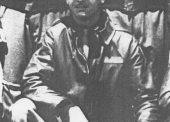
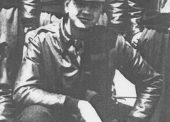
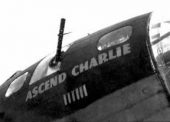
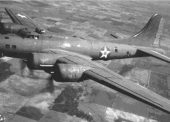
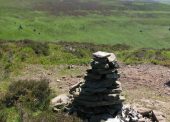
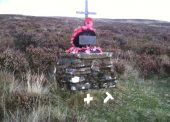
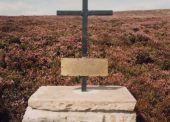
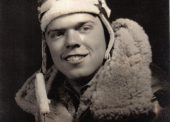
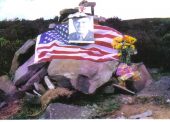
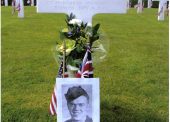
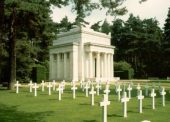
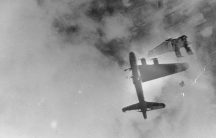
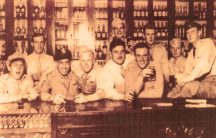
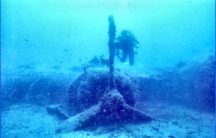
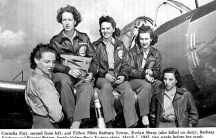
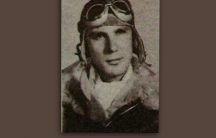
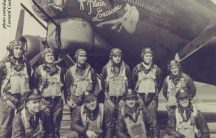











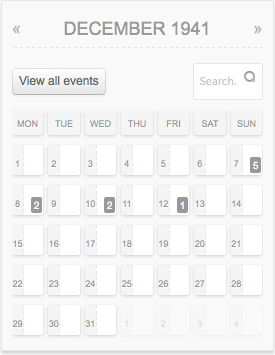







thanks for your story Bill, Ascend Charlie radio operator Staff Sargent Philip Catania was my Uncle, my Mother’s brother. I will travel to the UK on Thursday May 21 and will be in Wales soon and plan to hike to the cairn on June 7th. Francesca
Dear Francesca:
Thanks for this message. SSGT Catania is the member of the ‘Ascend Charlie’ crew about whom I know the least. I would love to get some more information about him. If possible, it would be great to seen a scanned photo of him. Also, do you know where he is buried? I assume it is in the area of Hartford, CT but would like to confirm.
Have a great trip to the UK and the Cairn.
Best regards, Bill
Hi Bill,
Philip would be my Great Uncle. My father was written to by a man in Wales who lives close to the crash site. He sent photos of the whole crew and great photos of Ascend Charlie as well as drawings of Ascend Charlie. I can scan some of the photos for you if you would be interested.
Hi Matt:
Sorry for the slow reply; I’ve been on the road. I would LOVE to see any photos or drawings or scans you have of your uncle or the crew. Of the men of ‘Ascend Charlie’, I know the least about your uncle. Do you happen to know where he is buried.
Best regards, Bill
Great story, Bill. I was doing a little research and came across an auction that include items from the wreckage:
http://online.auctionnation.com/auction/452/item/part-of-the-wreckage-of-lt-herb-turners-b17-425903-34-ascend-charlie34-390th-bomb-group-crashed-in-the-black-mountains-nw-of-the-abergavenn-wales-late-evening-16th-of-september-1943-33556
Thought you might find it interesting…
Hi Dan:
Thanks for this! It would have been incredible to attend that auction.
Best, Bill